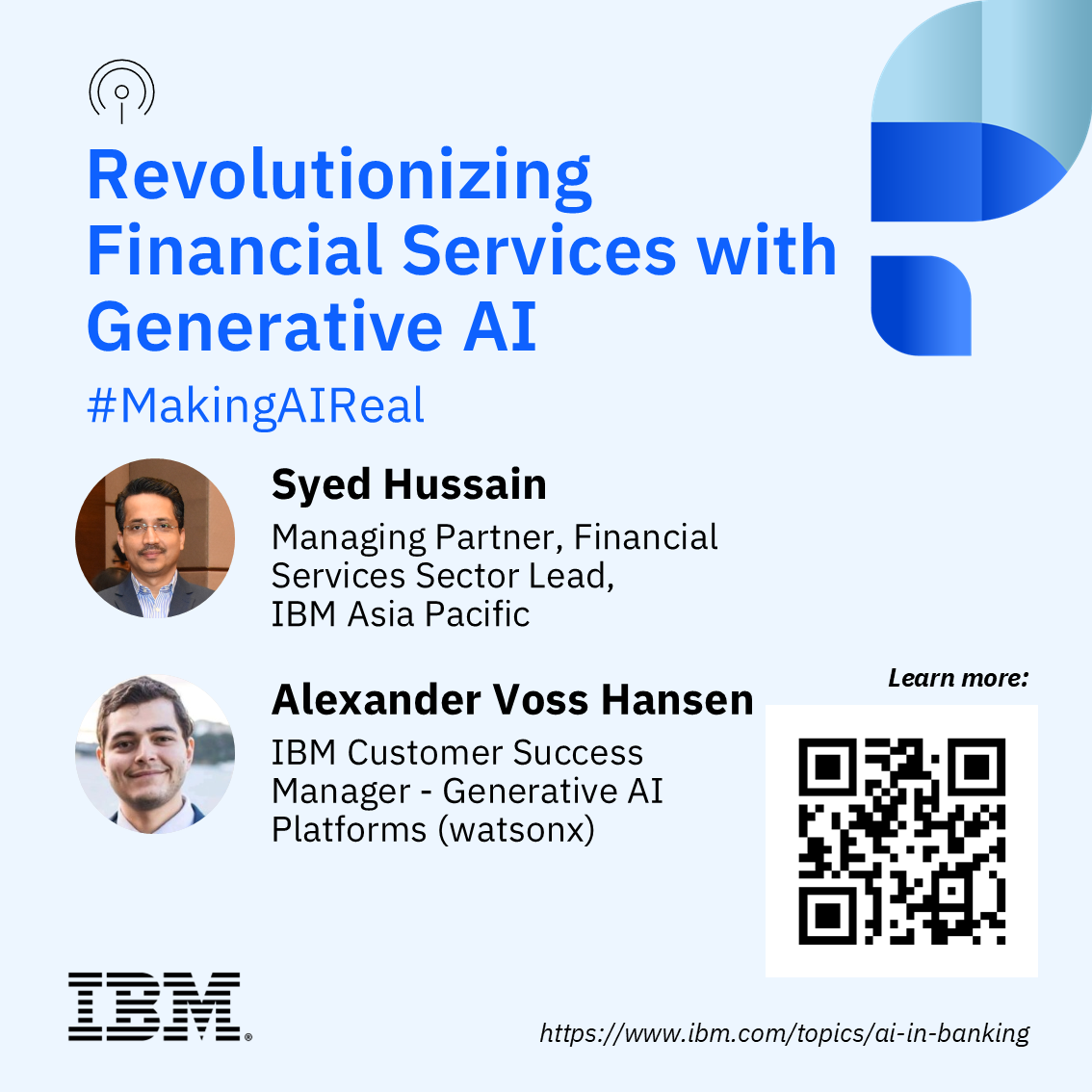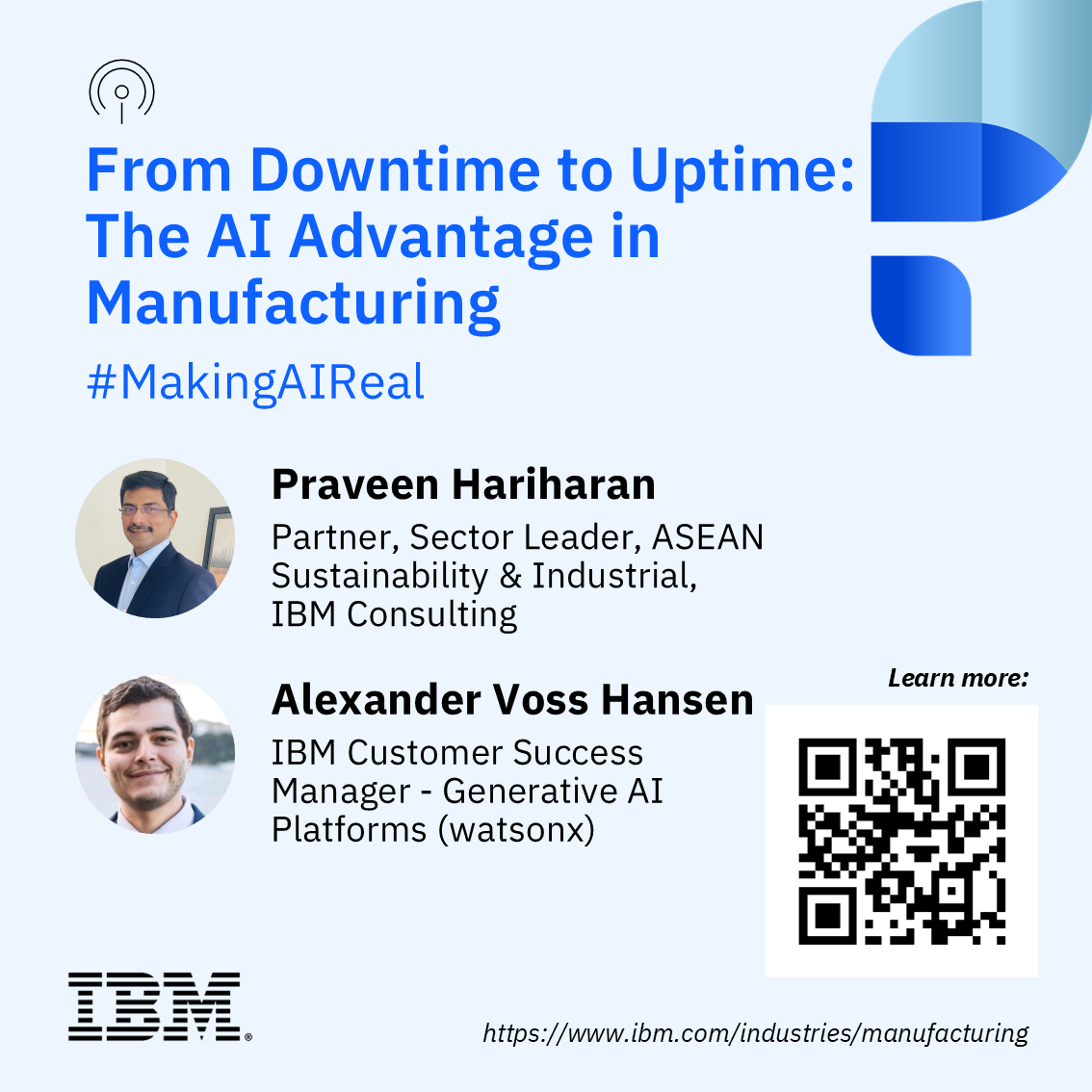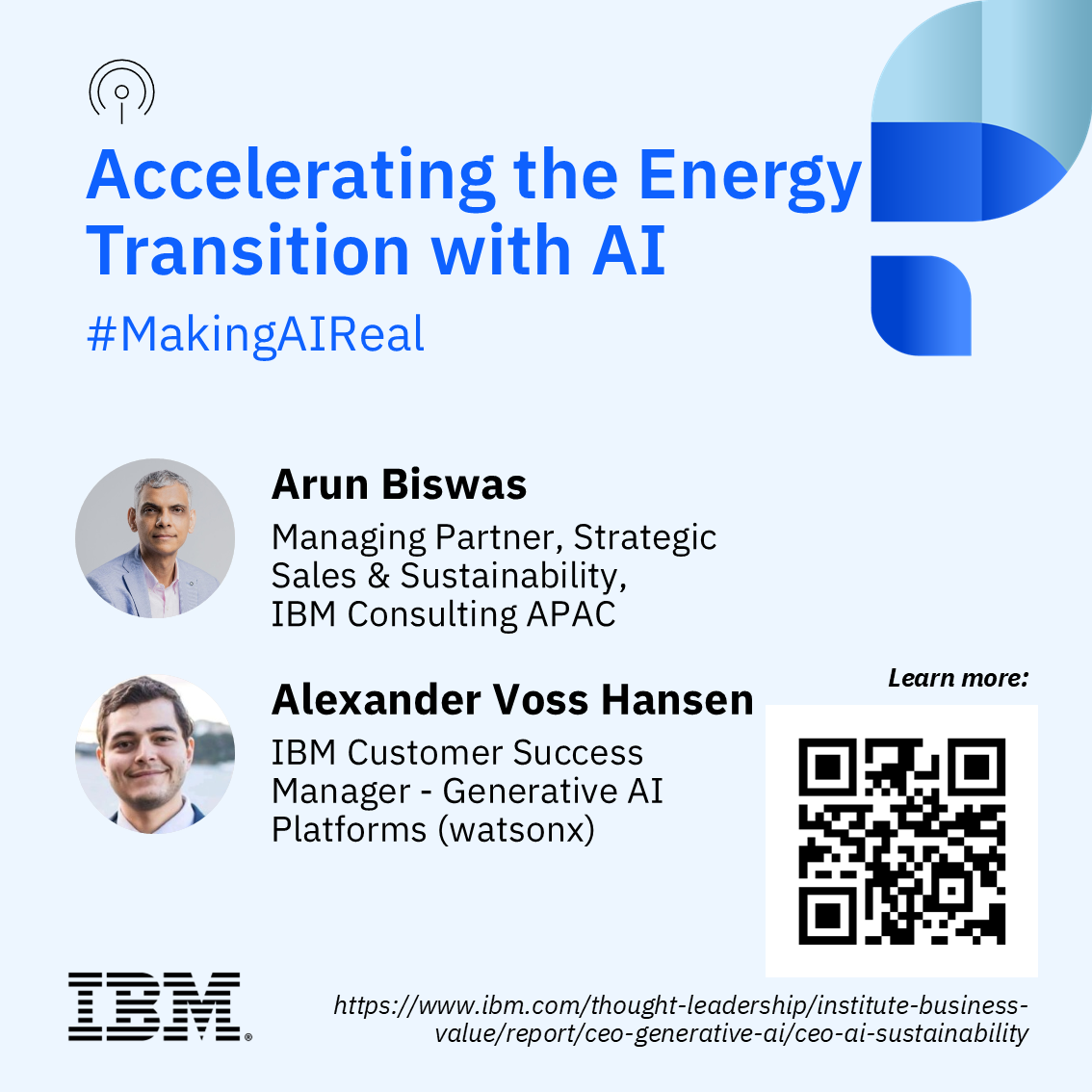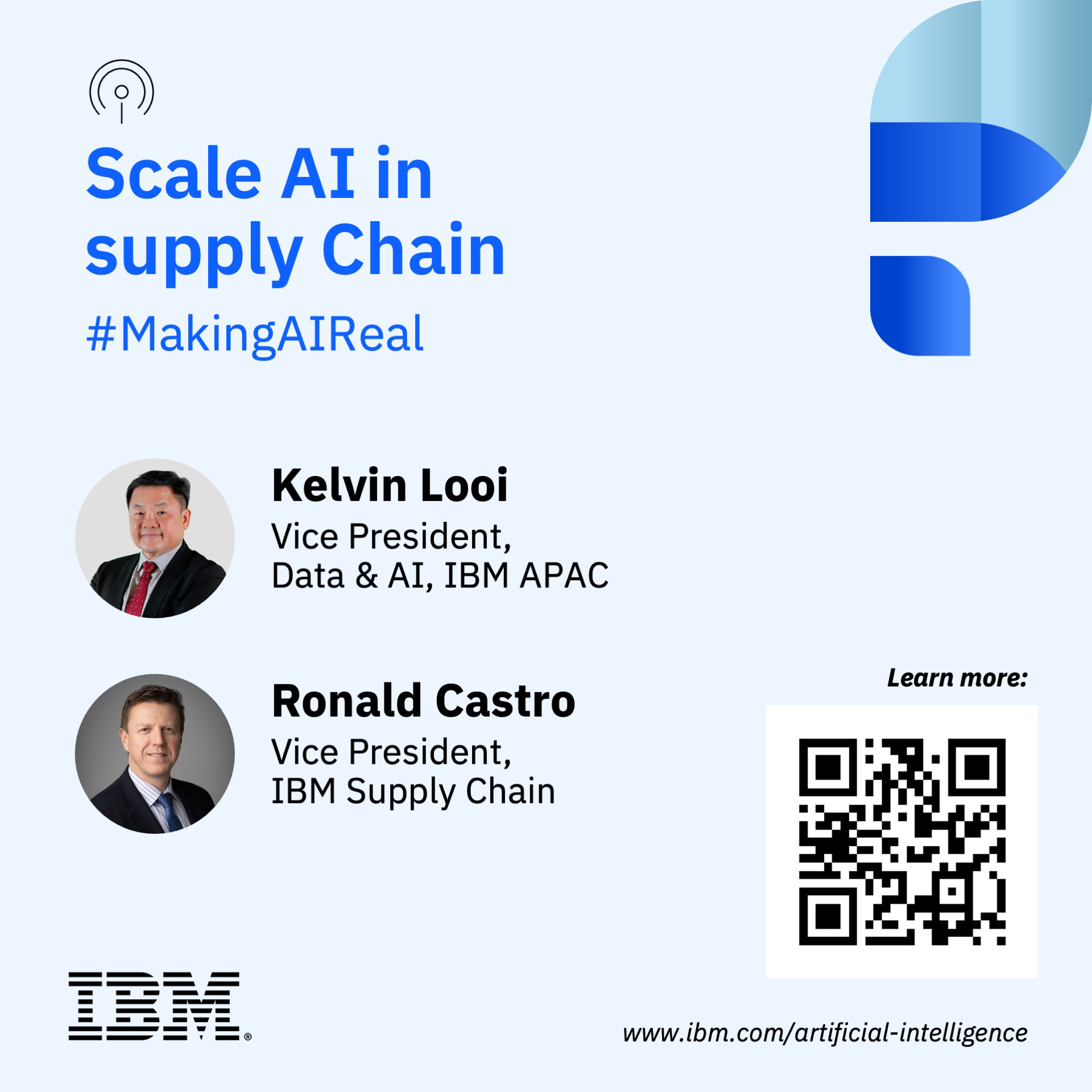Revolutionizing Financial Services with Generative AI
- 0.5
- 1
- 1.25
- 1.5
- 1.75
- 2
Alexander Voss Hansen: Hi everyone, and welcome to another installment of Making AI Real. I'm your host Alex Hansen, and in this series, we're striving to understand a little bit more about how IBM is driving to create real-world examples of value with generative AI and AI solutions. I'm joined today by managing partner, financial sector leader in the Asia-Pacific, Syed Hussain. So Syed, I have to tell you, I'm really looking forward to this particular session. The financial services industry will really propel the generative AI space with its impactful solutions. It's this industry that pioneers a great deal of innovation and I'd love to see what comes out of it and what we're doing now. AI is transforming many industries, but what do you see as the top use cases in banking and the financial services sector?
Syed Hussain: The number one use case that we see in financial services sector is around software development, code conversion, core modernization and testing, and there's a reason behind this. Leading and innovative banks and financial institutions are making significant investments in technology with 20 to 30% or even more of their total workforce engaged in digital data and cloud initiatives. Just imagine even a 10% point improvement in productivity within the software development life cycle or AIOps or testing can result in a substantial reduction in IT cost and overall salary-related expenses, while also accelerating their transformation agenda. The second use case is what we call agent assist, where GenAI is being used for dynamic scripting using retrieval augmented generation (RAG) patterns, enables the generation of most up-to-date answers, solutions, and responses to client requests, queries, and complaints. Generative AI is utilized for sentiment analysis of calls, providing agents with suggestions to respond with lot of empathy. Routine task automation includes scheduling of appointments, resetting passwords, and providing account information. GenAI is assisting in drafting email response, in call summarization, call analysis and classification. While leveraging generative AI, customer services team is able to improve customer satisfaction and reduce agent training time. The third use case we are observing is RM Assist, a co-pilot for relationship managers and financial advisors. Generative AI is enabling relationship managers to prepare more effectively for client meetings and engagements by analyzing vast amount of market data and research to produce summaries of trends, opportunities, and risks. In other words, generative AI is assisting relationship managers in enhancing their client interactions and discussions. Initially, Generative AI aids relationship managers in crafting personalized communication as well. It can generate draft of tailored material to be shared with clients such as client reports, newsletters, or even personalized research publications as we have demonstrated in IBM's collaboration with a leading European private sector bank.
Alexander Voss Hansen: I think those are some really relevant use cases. One particular thing that comes from the code assistant use case that you mentioned earlier is simply when you're working in a DevOps pipeline, a lot of people would have their own personalized way that they use coding and that can be an issue when it comes to standardization in the DevOps pipeline going into production, so it's a great way to kind of approach that issue as well. I like these real-world examples and they always resonate. Can you provide a case study where a financial institution has successfully leveraged generative AI and what's next to achieve a significant outcome in the software development or migration?
Syed Hussain: One of our client in the region in financial services sector has been looking at transforming and modernizing their relationship manager app, RM app by migrating from legacy Camel backend on Fuse to Spring Boot platform and also transitioning from an Angular frontend to ReactJS. Our client has been under tremendous time pressure as Apache Camel will cease to be supported after the end of 2025. We successfully partnered and completed a proof-of-concept utilizing IBM watsonx and Llama 3 model. IBM team employed watsonx.ai on the cloud to develop a generative AI-first approach for converting code from Camel to Spring Boot. Our team initially manually converted a segment of the code to fine-tune the large language model, Llama 3. Then we created a dependency graph, and in iterative way, defined the model using prompt engineering. We orchestrated and automated the conversion process, generating the graph and traversing it to produce the converted code with the right structure. Our SMEs reviewed the code and refined the code to ensure functional equivalence. We developed, tested, and deployed the code in a SIT environment. We achieved a core conversion accuracy of 70 to 75% or above and we were able to demonstrate to our client around 20 to 25% improvement in productivity within the entire software development lifecycle. And as we speak, we are now in the process of supporting the migration with around 20 to 25% reduction in migration cost and increasing program velocity.
Alexander Voss Hansen: It's a phenomenal story, Syed. What are the key capabilities that organizations should develop in order to industrialize AI and scale across the organization?
Syed Hussain: So based on our experience working with some of the banks, financial institutions globally, which are quite ahead of the curve in adopting and industrializing GenAI, I see there are five to six key capabilities that I would say every organization must adopt to scale and industrialize AI and GenAI. The most fundamental capability is to centralize and cleanse data while developing an effective knowledge base, which as per my experience, accounts for more than 50 to 60% of the substantial effort that is required in the entire AI and GenAI journey. The second priority should be to find an optimal balance between data privacy and protection, considering data risk, mobility, and compliance on one hand, and data utility, which encompasses accuracy, speed, scale, and simplicity on the other hand. Identifying the right approaches and technologies for masking, like tokenization, differential privacy, and anonymization is very crucial. The third focus should be on mitigating risk related to security and cybersecurity. The fourth area I would say involves trusted AI and governance, including a comprehensive model lifecycle management capability. And this enables organizations to ensure fairness, transparency, and explainability in their entire decision-making process. The fifth priority should be to invest in user experience and strong execution capability driven by insight. Specifically, it is important to ensure that end user can effectively execute end-to-end transaction based on insight that is getting generated from GenAI model. And I want to add that IBM Watson Orchestrate is an excellent tool for this purpose. Lastly, the most critical foundational aspect is the development of people, skill and talent, which requires a strong emphasis on training and upskilling.
Alexander Voss Hansen: Absolutely. You touched on some really great points there. Having governance, having a strategy, having transparency, identifying key areas for customer inlets to actually have a better experience. One thing I will pick up on though is you mentioned that development of skills and requiring a strong emphasis on training and upskilling. I'd like to add something on there as well, if I may. Leaning on your partner organizations, you know, IBM has decades of experience when it comes to AI and actual real-world implementations and research. I highly encourage anybody to work with us, work closely with us, have that co-creation, that co-partnership of authoring solutions. I think it might really help fill that gap as well as upskilling internally. One of the key capabilities you spoke about is model lifecycle management. Can you tell us about the LLM lifecycle management solution works that gives us an idea on how automation helps in different aspects of governance?
Syed Hussain: Yes. Model lifecycle management solution like we have in IBM watsonx has a strong capabilities across model governance, data governance, trust, transparency, fairness, bias and drift across multiple tools, applications, and platforms. Model lifecycle management solution has three main components, I would say. Number one, modern inventory management capabilities. This component captures essential information throughout the lifecycle including training metadata, deployment metadata, and model performance metadata, governance and workflow management capabilities. The solution includes workflows, dashboards, and incident management capabilities for effective model risk governance. And number three is evaluation and monitoring capability. This component focuses on assessing and monitoring key aspects such as I mentioned earlier, accuracy, drift, bias and explainability. It facilitates both pre-deployment, model evaluation, and post-deployment model monitoring.
Alexander Voss Hansen: This is something absolutely critical. I'm glad that we have Watson governance in order to promote that ability to deploy a model and monitor it remotely and check it for all these behaviors. By design, LLMs misbehave. They're alive, they learn, they lie, they change, and so we need to be able to predict and react when these things happen.
Syed Hussain: Yes, certainly. Yes.
Alexander Voss Hansen: Syed, thank you so much for joining us today. I feel like I've learned quite a lot from today's session and I hope our audience as well, I'm really interested to see where this space grows in the near future.
Syed Hussain: Alex, thanks a lot. Thanks for your time. Really appreciate.
Alexander Voss Hansen: Thank you for joining us.
DESCRIPTION
Making AI Real | Episode 6: Revolutionizing Financial Services with Generative AI
AI is transforming banking and financial services like never before!
In the latest 'Making AI Real' episode, Alexander Voss Hansen, Customer Success Manager, Specialty Architect - Generative AI Platforms (watsonx) and Syed Hussain, Managing Partner: Financial Services Sector Leader - APAC ; Industry Diamond Banking & FM, explore how generative AI is revolutionizing the industry.
Learn about real-world success stories, including how IBM watsonx enables productivity gains, cost efficiencies, and seamless AI adoption. With insights into trusted governance and AI lifecycle management, this episode is packed with actionable takeaways for the financial sector.
Discover more about the growing importance of AI in banking: https://www.ibm.com/topics/ai-in-banking








